Canada Remembers Times - 2008 Edition - Page 1
Download the PDF Version.
PDF Version 2.99 MB
Canada and the First World War
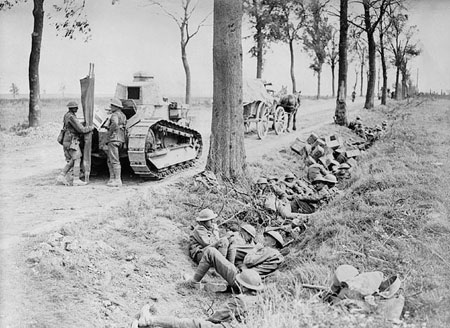
Canadian troops taking cover in a ditch alongside the road to Cambrai during "Canada's 100 Days."
Photo: Library and Archives Canada PA-003153
The First World War was fought from 1914 to 1918. It was the largest and most deadly war up to that time. For this reason it was called the "Great War." More than 650,000 Canadians and Newfoundlanders served and more than 66,000 of them died in service to their country.
Most of the Canadians and Newfoundlanders who saw action fought along Europe's "Western Front"-a line of trenches that stretched almost 1,000 kilometres across Belgium and France from the North Sea to the border of Switzerland.
Living in the trenches was a miserable experience. It was often cold and muddy with rats and fleas everywhere. Danger and death were ever-present due to enemy snipers, machine-gun fire and artillery bombardments. Canadian soldiers bravely overcame these challenges and were widely considered to be among the best of the Allied troops on the front. They played an important role in helping win the war with a series of impressive battlefield victories during the conflict's final months--a triumphant period known as "Canada's 100 Days."
In 2008, our country is taking the opportunity to honour these Canadians in ceremonies commemorating the 90th anniversary of the end of the fighting in the First World War. Ninety years is a long time and the world has changed in many ways, but the contributions and sacrifices they made played an important role in Canada's development into the free and peaceful country we have today.
Special Skills Required
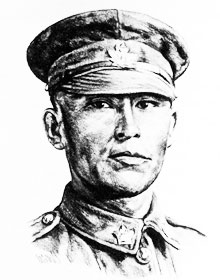
Cpl. Francis Pegahmagabow
Photo: VAC
Aboriginal-Canadian soldiers brought special skills to the army during the First World War. The traditional hunting and trapping lifestyles that many led in Canada often made them particularly skilled to work as snipers (military sharpshooters) and scouts (soldiers who quietly crossed the front lines to gather information about the enemy). They also served as dispatch carriers quickly running across great distances to deliver messages.
Francis Pegahmagabow was an Ojibwa-Cree from Ontario who served in the war. He was so skilled at reconnaissance it was said that he used to "go behind enemy lines, rub shoulders with the enemy forces and never get caught."
"Peggy," as he was called by his fellow soldiers, served bravely during almost the entire First World War and would become one of Canada's most-decorated soldiers.
Webcasting Remembrance
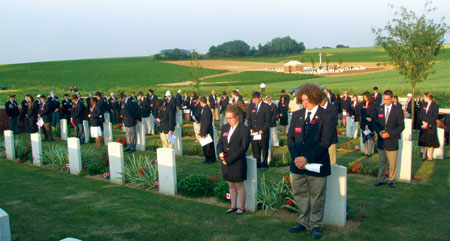
Youth delegates and Veterans gather for Candlelight Tribute Ceremony at the 2nd Sunken Road Cemetery near Beaumont-Hamel, France. June 2006.
Photo: VAC
In 2006, a group of 39 Canadian youth travelled to Europe as part of a Veterans Affairs Canada event in honour of the 90th anniversary of the Battle of the Somme. They were moved by their time in France, seeing firsthand the places in which Canadians served during the First World War. One young Canadian who visited a French war cemetery later shared a moving moment in a webcast:
"There was an inscription on a tombstone that said he was 16. The inscription said "Mother's Dearest" and I realized it could have been me or my brother or my cousin or a friend of mine … that was a really big moment for me."
Women at War
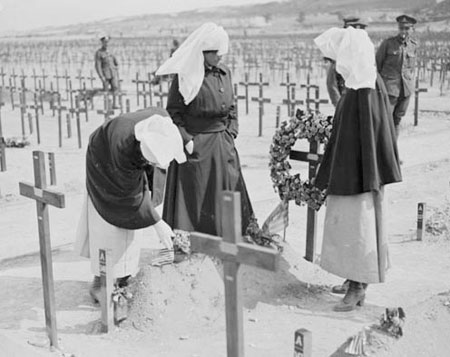
Nursing Sisters mark the grave of a fellow Canadian nurse who died in the air raid on Étaples, France
Photo: Library and Archives Canada PA-002474
The Canadian Nursing Sisters (military nurses) who cared for the sick and injured during the First World War were relied on and respected by those they helped. It could be a very dangerous job when these women served in casualty-clearing stations close to the battlefields. Even hospitals far from the front lines were not safe. Three Canadian Nursing Sisters were killed in a German bombing raid on a hospital in Étaples, France on May 19, 1918. In total, about 45 Canadian Nursing Sisters died during the First World War.
The contributions of Canadian women in the military have evolved over the past 90 years. Today, women serve in all roles in the Canadian Forces, including active combat in Afghanistan.
Letters from the Front
Today the Internet and long distance telephone calls help keep members of the Canadian Forces in touch with friends and family when they are serving far from home. During the First World War, letters and postcards were how people shared their news. It often took months to get mail from across the ocean. Here is a letter that Canadian soldier Harold Taylor wrote in April, 1917.
Dear Mother:
Well, it is quite a while since I wrote you a letter but when we are in the trenches, we do not get much time to write...
I received your parcel the other day, the one dated February 2nd, and believe me I was pleased to get it. Everything came in just right. It was just the kind of parcel that I like to get. Those chocolates and candy were great, and the insect powder sure did its work all right. I suppose that you have been worrying that I have not written sooner, but never worry about that for I always write whenever I have a chance, but in the trenches it is hard for us to write as we do not have much time for letters. But do not fret about me, because I am all right and am feeling fine. Of course, there is the unpleasant side and the hardships, too ...
The [Germans] were shelling one morning and a shell burst right amongst us and killed two and wounded four or five ...
I tell you they are a wicked thing when they land in a bunch of men ...
Give my love to everyone and write often.
Harold
We are saving you... YOU save FOOD
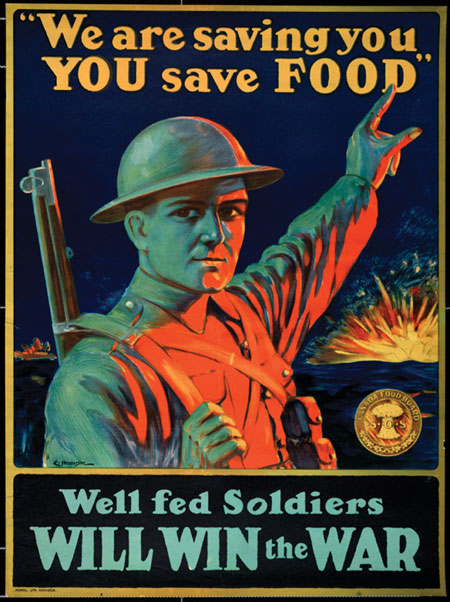
Canadians on the home front were expected to do their part in the war effort too, as shown in this poster encouraging people not to waste food.
Image: McGill Library Collection / WP1.F9.F2
- Date modified: